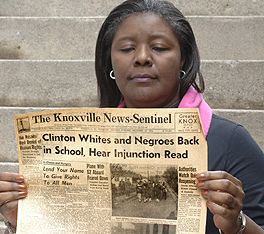News Release |
|
Media Contact: Mike Bradley Communications and Media Relations |
UT-Battelle supports Civil Rights memorial in Clinton

| |
Oak Ridge National Laboratory graphic designer Ernestine Sloan looks at a 50-year-old newpaper from a critical time in the Clinton desegregation uproar. ORNL managing contractor UT-Battelle is supporting the Green-Macadoo Cultural Center Museum's effort to commemorate the watershed events.
(hi-res image) | |
Oak Ridge National Laboratory's staff, with financial support from UT-Battelle, is copying thousands of historical newspapers and documents for a display in the Green McAdoo Cultural Center Museum, planned for the site of the old Green McAdoo School in Clinton. Green McAdoo, until 1956, was the city's school for black students and stayed in service as a middle school until 1965.
"This project will revive the memory of the city of Clinton's contribution to ending segregation's stranglehold on the nation's social fabric," said ORNL's Earnestine Sloan, an artistic leader for the memorial and former Green McAdoo student. "We are proud of what the memorial stands for and honored to be a part of it."
Sloan said the Creative Services team touched nearly 2000 newspaper articles, photos and other documents, scanning more than 500 of them.
The materials were presented to ORNL in two large cardboard boxes, gathered by Green-McAdoo committee members from closets, basements, attics and trunks of current and former members of the Clinton community.
The painstaking process included reading and matching up articles; cleaning and preparing fragile newspapers and old photos and the removal of discolorations. When ready, the items were scanned and archived on compact discs. The finished products were sent to Eisterhold Associates, a Kansas City-based cultural design firm.
Amidst the boxes of materials lay a wealth of fascinating stories. Sloan said that among the most intriguing were the reports of The Reverend Paul Turner, a Clinton Baptist pastor assaulted by an angry white gang as he escorted some black students to school.
The beating -- and Turner's courage -- gained national attention. One account used for the project was from the March 1957 edition of the pro-segregation American Nationalist and includes an interesting personal side-note, Sloan said.
"The copy we scanned for the project has a hand-written note scribbled at the top of the page that reads "How's your nose preacher?"' Sloan said. "The copy was apparently sent to Turner by one of his attackers."
Sloan also pointed out a New York Herald Tribune series about John Kasper, the outside agitator who led much of the charge against desegregation in Clinton. The articles show that only a year earlier, Kasper was owner of a bookstore in Greenwich Village, N.Y., that encouraged integration and promoted social events, parties and dances welcoming both black and white attendees. The stories include photos of Kasper apparently sharing good times with young adults of both races in his bookstore.
UT-Battelle's $50,000 exhibit, scheduled for completion in August, will consist of copies from newspapers across the country, including the Clinton Courier News, which garnered national recognition for exceptional coverage of the events.
In the early 1950s, a local group challenged Clinton school segregation policies with a lawsuit, one of a number of efforts to dismantle Jim Crow statues across the country. Later, the historic 1954 Supreme Court Brown vs. Board of Education decision in effect outlawed school segregation.
In 1956 a dozen African American students, backed by white civic leaders including Turner, arrived at the all-white Clinton High School to enroll.
Recorded accounts report little local protest initially, but the procession drew national media and soon disapproving residents and agitators from other states and cities, including John Kasper, had formed a mob.
State troopers arrived to avert a melee. The school was integrated, but the unrest continued, resulting in a Saturday-night bombing of Clinton High School in 1958. That unsolved crime might have swung attitudes away from the segregationists. Even a right-wing commentator of the era, Westbrook Pegler, raised money nationally to rebuild the school.
"Historic Civil Rights events in cities like Birmingham and Little Rock may have gotten more national publicity, but the events in Clinton were equally important," Sloan said. "This project not only preserves that history, but conveys the personalities, complexities and heroism of many of the individuals involved."


